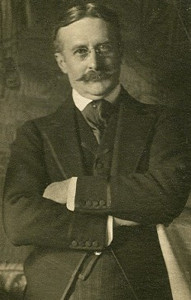 Imagine Mike Ashley or Philip Green sitting down every day to compose a feature article in a leading national newspaper for the amusement and edification of regular or prospective customers of their department stores. It’s impossible to contemplate. Yet in the early years of his flagship store in London’s Oxford Street this is exactly what Gordon Selfridge ( 1858 – 1947) did to publicise the enterprise he had founded in 1908.
Imagine Mike Ashley or Philip Green sitting down every day to compose a feature article in a leading national newspaper for the amusement and edification of regular or prospective customers of their department stores. It’s impossible to contemplate. Yet in the early years of his flagship store in London’s Oxford Street this is exactly what Gordon Selfridge ( 1858 – 1947) did to publicise the enterprise he had founded in 1908.
Each day for 27 years Selfridge, under the pseudonym ‘ Callisthenes ‘, published a short essay reflecting ‘ the policies, principles and opinions of this House of Business upon various points of public interest.’ The articles appear to have begun around 1910, only months after his store had opened for business. From 1924 they appeared in the ‘ entertainment’ page of the Times and two hundred of these Times articles from 1930 were collected in book form under the Selfridge imprint in 1933; further articles continued to be published for another four years.
In collecting together these articles, which in their original form provoked responses from all over the world, Selfridge was at pains to emphasise that they were never written to be collected as serious literary essays. Rather they represented ‘a unique feature of modern publicity ‘framed as ‘modern, topical journalism’.
Selfridge’s range of subject matter was impressive. He was capable of writing lucidly and cogently on such contemporary issues as the successful life, the chief use of criticism, genius in business, education for management, why the world needs more rich men, keeping one’s eye on the object, the quality of work, the duty of advertisement, objections to pension schemes, and fitting in. He devoted seven articles outlining the pros and cons of employing public schoolboys. He himself had left school at 14. Selfridge grew to love London. He praised it for its size and defended the safety and longevity of the Crystal Palace. Unfortunately, not long after he lauded this iconic building it was burnt to the ground.
The opinions of Selfridge as they were expressed in two hundred articles running to 340 pages cannot be summed up in one short Jot. Suffice it to say that his views on capitalism and progress, the importance of initiative and leadership, the merit of imagination, hard work and dedication to a vision, were as forcefully expressed as one might imagine for a man who presided over what became the second largest department store in the world. What are perhaps more interesting are the things he was prepared to reveal about Selfridges. For instance, we are told that his department store was the only one in the world to record earthquakes through a state of the art seismograph located in a case on the third floor, next to the Bureau of Information. According to Selfridge, the presence of this fascinating example of modern science ‘will help to make our Store till more emphatically a centre of interest and knowledge and progress in the life of London’.
The autodidact Selfridge was widely read too. He quoted Bacon, Edward Fitzgerald and William Blake, and perhaps more predictably, was a great admirer of John Masefield. But although he was wedded to the idea of progress, Modernism in Art or literature did not appeal. If it sold paintings one could imagine the sort of paintings that one could buy in Selfridges.
Selfridge, as one might expect, touted his requisites for success in ‘modern business life’. These included:
‘Judgement, good common sense 25%
Imagination, vision 15%
Energy, physical and mental 12%
Determination, strength of purpose 12%
Courage, willingness to take risks 11%
Ambition 11%
Self-confidence—after it has been fairly won 10%
This leaves 5 per cent, which we may allot to the following group:
Tact, knowledge of human nature;
Adaptability, fitting into new surroundings;
Appreciation of the value of time;
Cheerfulness under all conditions
Indifference to obstacles…’
[R.M.H]

Dónde se pueden conseguir estos artículos escritos por Calístenes?
Cómo se llama el libro de ventas escrito por Calistenes y dónde se puede conseguir?